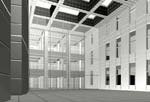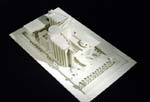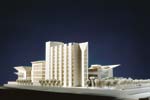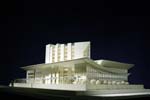
|
|
|
|
 |
|
|
|
|
|
Dhaka Apollo Hospital in Bangladesh by SmithGroup
by ArchNewsNow October 14, 2002 U.S.-based SmithGroup has
designed the Dhaka Apollo Hospital to respond to the cultural, social, and spiritual traditions of
Bangladesh, while incorporating state-of-the-art western medical technology. The
hospital is intended to be recognizable as a world-class facility and a symbol
for the future of Bangladesh. The
334,000-square-foot, 330-bed facility is divided into three basic building components:
the outpatient clinical building, the main hospital, and the service building. Separating the outpatient clinic from the main
hospital creates a public plaza as a gathering area for the large numbers of
visitors. It also separates the inpatient hospital from heavy daytime
outpatient traffic to the clinics, and allows specialty clinic services to be
placed adjacent to the corresponding floors of the diagnostic and treatment
area in the main hospital block. The
three-component design, necessary for the efficient everyday function of the
hospital, is overlaid by the four-quadrant approach of Vastu, a system
of design closely tied to the spiritual beliefs of Hinduism. (Though 87% of
Bangladeshis are Muslim, Hindu beliefs and cultural norms are common in public
spaces.) Each quadrant refers to one basic element, Earth, Air, Fire, and
Water, each of which carries its own influence over both the interior and
exterior design. For example, the Air quadrant, in the northwest, is best
suited for landscaping. The Water quadrant should incorporate a water feature. The open-air plaza
fronting the main entrance represents Space, the fifth element of Vastu.
Located at the
terminus of the entrance sequence are a grand canopy and a series of monumental
steps leading to the glazed pedestrian arcade. This is where families and
groups of well-wishers – who can number as many as a dozen per patient at
Bangladesh hospitals – can gather, making the plaza a grand public space
located at the heart of the project in celebration of humanity. Vastu
also influences the site shape (which should be square or rectangle), and the
alignment of the site according to cardinal directions. The land should be
elevated toward to south and west sides, and lower on the north and east sides.
Patient
suites feature balconies and terraces, which bring the natural environment in
and open vistas out to the green fields sweeping the horizon. Connecting the
two patient wings is a centrally located glazed circulation element. This
curving form provides views to the landscape, while serving as a recognizable
building image for arriving visitors. Members
of Apollo Hospitals Enterprise Ltd. are associate architects on the project,
which is scheduled for competition in December 2004. SmithGroup, Inc. ranks as the nation’s 5th
largest architecture, engineering, and planning firm and employs 1,000. It is
composed of client industry-focused Solution Groups serving the health care,
education, workplace, technologies, research, and government sectors. The firm has
offices in Ann Arbor, MI; Chicago; Detroit; Los Angeles; Madison, WI; Phoenix;
San Francisco; and Washington, D.C. Founded in 1853, SmithGroup will celebrate
its 150th anniversary in 2003, and is the oldest operating A/E in
the U.S. |
(click on pictures to enlarge)  (SmithGroup) A grand canopy marks the main entrance to the Dhaka Apollo Hospital in Dhaka, Bangladesh. (SmithGroup) The entry plaza and glazed arcade (SmithGroup) The siting and design is based on the four-quadrant elements of Vastu, a system of design closely tied to the spiritual beliefs of Hinduism. (SmithGroup) Model (SmithGroup) Model (SmithGroup) Floorplan (SmithGroup) Another view of the grand entry canopy |
© 2002 ArchNewsNow.com